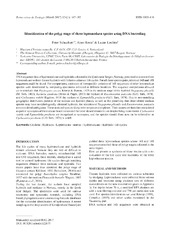| dc.contributor.author | Schuchert, Peter | |
| dc.contributor.author | Hosia, Aino | |
| dc.contributor.author | Leclere, Lucas Pierre Jean | |
| dc.date.accessioned | 2018-04-06T08:37:49Z | |
| dc.date.available | 2018-04-06T08:37:49Z | |
| dc.date.issued | 2017 | |
| dc.Published | Schuchert P, Hosia A, Leclere LPJ. Identification of the polyp stage of three leptomedusa species using DNA barcoding. Revue suisse de zoologie. 2017;124(1):167-182 | eng |
| dc.identifier.issn | 0035-418X | |
| dc.identifier.uri | https://hdl.handle.net/1956/17575 | |
| dc.description.abstract | DNA sequence data of hydromedusae and hydroids collected in the fjords near Bergen, Norway, permitted to connect three leptomedusae to three thecate hydroids with hitherto unknown life cycles. For all three species pairs, identical 16S and 18S sequences could be found. For comparisons, estimates of intraspecifi c variation of 16S sequences of other leptomedusa species were determined by comparing specimens collected at different localities. The sequence comparisons allowed us to conclude that Ptychogena crocea Kramp & Dumas, 1925 is the medusa stage of the hydroid Stegopoma plicatile (M. Sars, 1863), Earleria quadrata (Hosia & Pages, 2007) the medusa of Racemoramus panicula (G.O. Sars, 1874), and Cyclocanna welshi Bigelow, 1918 the medusa of Egmundella producta (G.O. Sars, 1874). Due to non-matching geographic distribution patterns of the medusa and hydroid phases, as well as the possibility that other related medusa species may have morphologically identical hydroids, the identities of Stegopoma plicatile and Racemoramus panicula are considered ambiguous. These nominal species likely refer to species complexes. Their names are therefore considered as partial synonyms of the medusa-based names and the latter should remain in use despite being more recent. Cyclocanna welshi and Egmundella producta are recognised as synonyms, and the species should from now on be referred to as Cyclocanna producta (G.O. Sars, 1874) n. comb. | en_US |
| dc.language.iso | eng | eng |
| dc.publisher | Geneva Museum and the Swiss Zoological Society | eng |
| dc.relation.uri | https://www.researchgate.net/profile/Peter_Schuchert/publication/315772160_Identification_of_the_polyp_stage_of_three_leptomedusa_species_using_DNA_barcoding/links/58e3b0700f7e9b7c2eb5f6f6/Identificat | |
| dc.rights | Attribution CC BY | eng |
| dc.rights.uri | http://creativecommons.org/licenses/by/4.0 | eng |
| dc.subject | Cnidaria | eng |
| dc.subject | Hydrozoa | eng |
| dc.subject | Leptothecata | eng |
| dc.subject | marine | eng |
| dc.subject | hydromedusae | eng |
| dc.subject | hydroids | eng |
| dc.subject | life cycles | eng |
| dc.title | Identification of the polyp stage of three leptomedusa species using DNA barcoding | eng |
| dc.type | Peer reviewed | en_US |
| dc.type | Journal article | en_US |
| dc.date.updated | 2018-01-18T09:11:09Z | |
| dc.description.version | publishedVersion | |
| dc.rights.holder | Copyright 2017 The Author(s) | eng |
| dc.identifier.doi | https://doi.org/10.5281/zenodo.322675 | |
| dc.identifier.cristin | 1494113 | |
| dc.source.journal | Revue suisse de zoologie | |
| dc.relation.project | Artsdatabanken: 70184233 | |
| dc.relation.project | Artsdatabanken: 70184215 | |
| dc.relation.project | Norges forskningsråd: 248799 | |
| dc.relation.project | Artsdatabanken: 14-14, 70184209 | |
| dc.relation.project | Norges forskningsråd: 226134/F50 | |
| dc.relation.project | Artsdatabanken: 248799 | |

